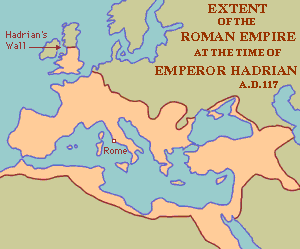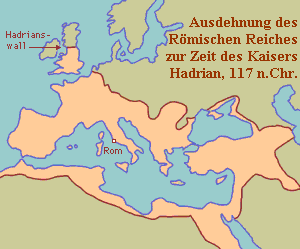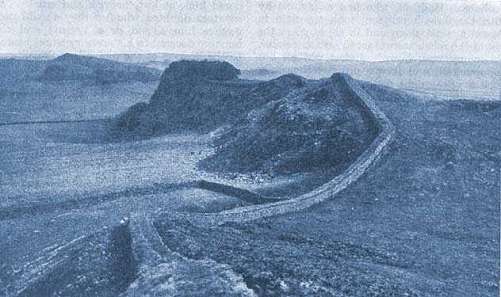 |
|
One of the greatest monuments to the power - and limitations - of the Roman Empire, Hadrian's Wall ran for 73 miles across open country. Why was it built?
At the time of Julius Ceasar's first small invasion of the south coast of Britain in 55 BC, the British Isles, like much of mainland Europe was inhabited by many Celtic tribes loosely united by a similar language and culture but nevertheless each distinct. He returned the next year and encountered the 4000 war chariots of the Catevellauni in a land "protected by forests and marshes, and filled with a great number of men and cattle." He defeated the Catevellauni and then withdrew, though not before establishing treaties and alliances. Thus began the Roman occupation of Britain. Nearly 100 years later, in 43 AD, the Emperor Claudius sent Aulus Plautius and about 24,000 soldiers to Britain, this time to establish control under a military presence. Although subjugation of southern Britain proceeded fairly smoothly by a combination of military might and clever diplomacy, and by 79 AD what is now England and Wales were firmly under control, the far North remained a problem. However, the Emperor Vespasian decided that what is now Scotland should also be incorporated into the Roman Empire. Under his instructions the governor of Britian, Julius Agricola, subdued the Southern Scottish tribal clans, the Selgovae, Novantae and Votadini by 81 AD. Further to the North lived loose associations of clans known collectively as the Caledonians. Agricola tried to provoke them into battle by marching an army into the Highlands eventually forcing a battle with the Caledonian leader Calgacus in present day Aberdeenshire at a place called Mons Graupius. 30,000 Caledonians were killed, but the Roman victory was a hollow one, for the next day the surviving clansmen melted away into the hills, and were to remain fiercely resistant and independent.
|
Eines der grössten Monumente für
die Macht - und die Begrenzungen - des römischen Reiches,
der Hadrianswall, lief 118km über offenes Land. Warum wurde
er gebaut?
Zur Zeit Julius Caesars erster Invasion an der Südküste Britanniens, 55 v.Chr., waren die Britischen Inseln, wie sonst viele Gebiete in Europa, durch keltische Stämme, die lose miteinander verbunden waren, bewohnt. Sprache und Kultur waren einander ähnlich, und doch jede eigenständig. Er kam ein Jahr später wieder, gegen die 4000 Streitwagen Catevellaunis in einem Land "geschützt durch Wälder und Moore, voll Menschen und Herden." Er schlug die Catevellauni, zog sich wieder zurück, ging aber vorher Verträge und Bündnisse ein. So begann die Römische Besetzung Britanniens. Beinahe 100 Jahre später, in 43 n.Chr., sandte Kaiser Claudius Aulus Plautius mit etwa 24'000 Soldaten nach Britannien, diesmal um die militärische Kontrolle zu errichten. Die Unterwerfung des südlichen Britanniens ging gut voran, durch militärisches und diplomatisches Geschick waren bis 79 n.Chr. England und Wales unter Kontrolle. Der Norden blieb aber ein Problem. Der Kaiser Vespasian entschied aber, dass das heutige Schottland ebenfalls in das Römische Reich integriert werden sollte. Gemäss seinen Anweisungen unterwarf der Statthalter Britanniens, Julius Agricola, die Schottischen Stammes-Clans, die Selgovae, Novantae und Botadini bis 81 n.Chr. Weiter nördlich lebten lose verbundene Stämme allgemein als Kaledonier bekannt. Agricola versuchte sie zum Kampf zu provozieren, indem er mit einer Armee in das Hochland marschierte und es mit dem Kaledonischen Führer Calgacus beim heutigen Aberdeenshire beim Mons Graupius zur Schlacht kam. 30'000 Kaledonier starben, aber der Römische Sieg war schal. Sofort zogen sich die Clan-Männer in die Hügel zurück, leisteten weiterhin erbittert Widerstand und blieben unabhängig.
|
 By the time Hadrian became Emperor in 117 AD the Roman Empire had ceased to expand. Hadrian was concerned to consolidate his boundaries. He visited Britain in 122 AD, and ordered a wall to be built between the Solway Firth in the West and the River Tyne in the east "to separate Romans from Barbarians".
By the time Hadrian became Emperor in 117 AD the Roman Empire had ceased to expand. Hadrian was concerned to consolidate his boundaries. He visited Britain in 122 AD, and ordered a wall to be built between the Solway Firth in the West and the River Tyne in the east "to separate Romans from Barbarians".
 Als Hadrian in 117 n.Chr. Kaiser wurde, dehnte sich
das Römische Reich nicht mehr aus. Hadrian suchte seine
Grenzen zu festigen. Er besuchte Britannien 122 n.Chr. und befahl
einen Wall zwischen der Solway-Bucht im Westen und dem Fluss
Tyne im Osten zu errichten, "um die Römer von den
Barbaren zu trennen".
Als Hadrian in 117 n.Chr. Kaiser wurde, dehnte sich
das Römische Reich nicht mehr aus. Hadrian suchte seine
Grenzen zu festigen. Er besuchte Britannien 122 n.Chr. und befahl
einen Wall zwischen der Solway-Bucht im Westen und dem Fluss
Tyne im Osten zu errichten, "um die Römer von den
Barbaren zu trennen".
